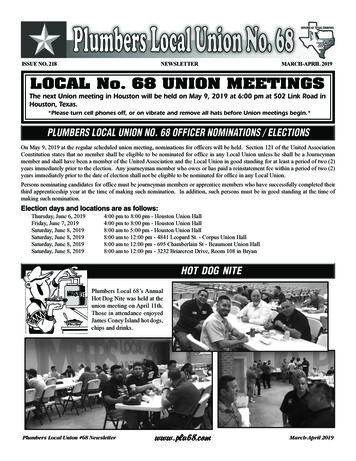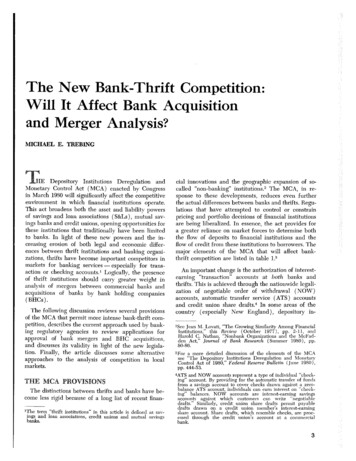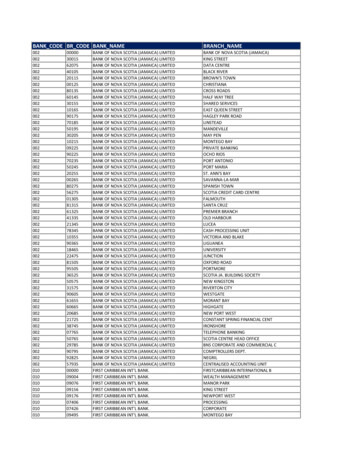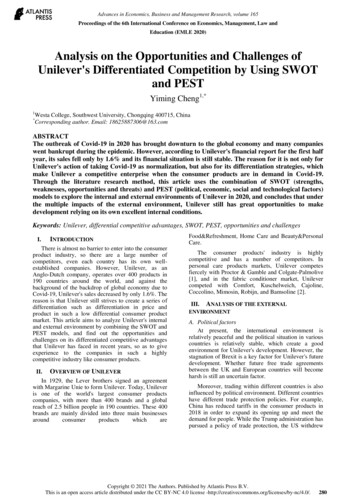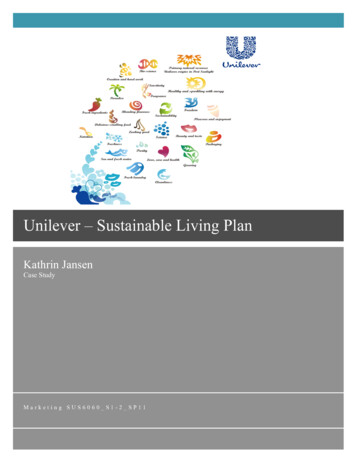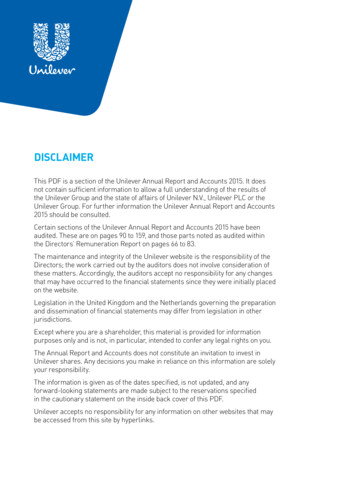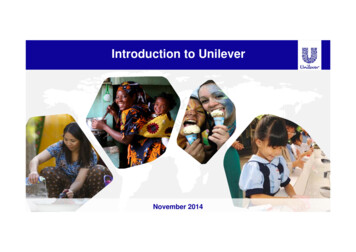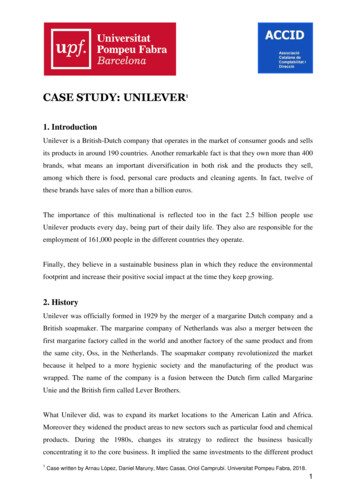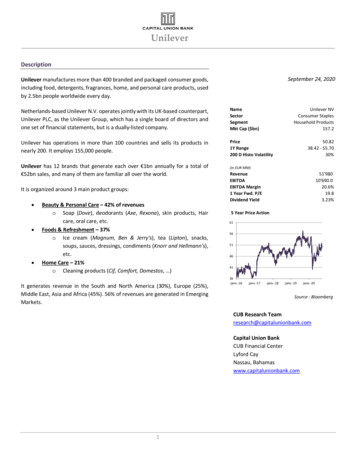
Transcription
UnileverDescriptionSeptember 24, 2020Unilever manufactures more than 400 branded and packaged consumer goods,including food, detergents, fragrances, home, and personal care products, usedby 2.5bn people worldwide every day.Netherlands-based Unilever N.V. operates jointly with its UK-based counterpart,Unilever PLC, as the Unilever Group, which has a single board of directors andone set of financial statements, but is a dually-listed company.NameSectorSegmentMkt Cap ( bn)Unilever has operations in more than 100 countries and sells its products innearly 200. It employs 155,000 people.Price1Y Range200 D Histo VolatilityUnilever has 12 brands that generate each over 1bn annually for a total of 52bn sales, and many of them are familiar all over the world.It is organized around 3 main product groups: Beauty & Personal Care – 42% of revenueso Soap (Dove), deodorants (Axe, Rexona), skin products, Haircare, oral care, etc.Foods & Refreshment – 37%o Ice cream (Magnum, Ben & Jerry's), tea (Lipton), snacks,soups, sauces, dressings, condiments (Knorr and Hellmann's),etc.Home Care – 21%o Cleaning products (Cif, Comfort, Domestos, )It generates revenue in the South and North America (30%), Europe (25%),Middle East, Asia and Africa (45%). 56% of revenues are generated in EmergingMarkets.Unilever NVConsumer StaplesHousehold Products157.250.8238.42 - 55.7030%(in EUR MM)RevenueEBITDAEBITDA Margin1 Year Fwd. P/EDividend Yield51'98010'690.020.6%19.83.23%5 Year Price janv.-20Source : BloombergCUB Research Teamresearch@capitalunionbank.comCapital Union BankCUB Financial CenterLyford CayNassau, Bahamaswww.capitalunionbank.com1
UnileverBrands Major Brands by segmentDigital technologies & sustainable growth Digital transformation and big dataDigital transformation and big data are also at heart of Unilever’s new strategy. While the traditional approach is to buy customer datafrom a market research firm, Unilever is rapidly building its own database using online customer registrations, third-party sites thatconsumers visit and data from store loyalty cards. It has amassed 900mn individual customer records so far, up from 200mn a yearago. The company has created teams in digital technology, who study the data for consumer traits, segment them and scale it acrossan entire country to better forecast demand.To pitch Baby Dove in India for example, Unilever first assembled data on homes that were known to buy infant products, thendelivered Baby Dove messages directly to look-alike audience on Facebook accounts and did the same thing on YouTube. Overallresults were promising, as typically, for such a product, Unilever in India spends 500k monthly on TV and digital marketing. The newmethod cost just 100k and yielded a bigger jump in brand awareness.Big data can also help bring products to market faster. The company launched last year a product in China, which claims to protect theskin from pollution. The brand, born entirely out of data, was co-created with Alibaba. Unilever used the Chinese company's ecommerce platform to get real-time feedback and consumer insights to design and develop the product. Within seven months, it waslaunched on Alibaba platform. Unilever has already explored 200 data-driven products, and 20% of these have been launched. Sustainable growthUnilever wants to reduce its environment impact as many other companies. Sustainable growth has become the pillar of itsdevelopment and Unilever has already taken many actions. Since last year, all its factories are powered by 100% renewable gridelectricity. It also committed to halve its use of virgin plastic in its packaging by 2025 and to replace it by reuse plastic.2
UnileverRecent Events Recent acquisitions and divestitureso In early 2017 Kraft Heinz made a 143bn takeover offer but Unilever management and stockholders protested,claiming the bid underestimated its value. It would have been the largest takeover in the industry, combining dozensof global household names.o Since Kraft Heinz withdrew its offer, Unilever has stepped up its cost-cutting efforts. With plans to cut 6 billion fromoperational costs by 2020, the company has slashed its advertising budget and reduced staff, among other savingsinitiatives.o At the end of 2017, Unilever acquired Hourglass, a maker of luxury cosmetic products, to add it to its portfolio ofPrestige cosmetic brands. This product line has exhibited high growth-rates that are driven by social media contentand channel diversity.o In 2018, Foods and Refreshment segments were combined to increase internal synergies. Unilever’s 4 core businessgroups were then reduced to 3 categories.o Last month, the company announced the result of its strategic review of the Tea business, which includes leadingbrands such as Lipton. Unilever estimated the potential of its tea brands can be best achieved as a separate entity,which should conclude by the end of 2021. 2bn of Unilever’s sales are concerned. Review of the dual listingo Recently, the group has announced plans to unify its Group legal structure under its UK entity, after the abandonedattempt in 2018. This simplification of the structure facilitates the use of equity for mergers and reduces thecomplexity associated with larger-scale divestments. While due to complete in November 2020, the unificationprocess is now at risk from a proposed tax change by the Dutch Green Party in the case of certain cross-bordermergers that could see Unilever facing an 11bn tax liability if it unifies and delists the Dutch entity. Unilever hasstated that any such risk materializing would see it abandon its current plans. The exact timing of the proposed taxlaw is still unclear, but there are serious doubts on the compatibility of the proposal with EU law. 2020 resultso In 1Q20, net sales growth was flat, as sales increased by 0.2% but negative price impacted 0.2%.o In 2Q20, the company released a better-than-expected organic sales growth (-0.3% vs consensus -4.3%), led byresilient volume growth and positive price growth. Home ice cream and dressings partially offset a 30-40% declinein out of home consumption, and hygiene-related products, which directly benefit from heightened demand due toCovid-impacted consumer habits, both helped the share price to recover to its mid-June levels.o This surprisingly good quarter provided an opportunity to abandon its 20% medium-term margin target (from 16.4%in 2016), which had been announced by the management to convince its shareholders to refuse the unwelcomedapproach by Kraft Heinz. Many investors had reproached this margin target lead to continuous under-investment inorder to deliver on the metric. FY20 operating margin should attain a sustainable 18.5% level.o In 1H20, operating margin increased 0.5% (vs consensus -0.5%), driven by a reduction in marketing investment of1%. Free cash flow increased strongly to 2.9bn (vs. 1.3bn in 1H19) driven by working capital improvements, somecash tax benefits and reduced capex.3
UnileverInvestment CaseDisappointing sales growth has put pressure on management to execute a major transformational change to Unilever’s portfolio, andan uncertain outlook on margin development has weighed on the share price. The stock has recently lagged its competitors, such asProcter & Gamble or Nestlé, but we believe that a few major points can help the stock re-rate and catch up with its peer group.Unilever is a big company with leading brands and solid balance sheet, which bring stability to an investor portfolio. The company hassucceeded to maintain its sales despite the economic slowdown, supported by in home consumption, and maintained its dividendthrough the pandemic.The new CEO, who took the reins at the end of 2018, is shifting the target for the group away from margin delivery and is continuingthe transformation towards health and beauty brands and to the detriment of food brands showing slow growth. Unilever is alsostrategically modifying its portfolio towards more premium brands. More expensive products are better suited for the demographicwave of new entrants to the upper middle class income levels (for example in China). Both changes should increase longer-term growthprospects.Potential acquisitions are a likely result as Unilever is trying to unify its dual-listed share, which should simplify M&A deals. Directcompetitor Reckitt Benckiser would be a possible target. To sustain future growth, management also intends to focus more onemerging countries. The company has recently acquired a few companies in India where it is gaining market share in most of itssegments.The company has room to increase its e-commerce as a significant distribution channel, as online sales development is here to stay.In 1H20, 8% of sales were through e-commerce and should increase up to 30% in the next few years.We believe Unilever’s more defensive portfolio limits downside and the stock should re-rate in the coming months thanks to anambitious strategic change, maybe through an important merger/acquisition. With its leading position in many segments, Unilever isa core holding in European portfolios.Bullish Case Bearish CaseRebound of the global economy from the Covid crisisBetter-than-expected acceleration in sales growth inemerging marketsStrategic restructuringo Successful turnaround in Food & Refreshmentbusiness growtho Disposal of underperforming assets and/oraccretive acquisitionso Stronger than expected cost savings programso Operational improvement of the productionchain4 Lower economic growtho Weak consumer demand implying low pricingpowerIncreasing competition in Emerging Countrieso Continued sales underperformance owing toshare lossRise in input costsWeakness in EM currencies (60% of sales) affectingearningsDelayed restructuring weights on investors’ sentiment
UnileverSWOT AnalysisStrengths WeaknessesStable and diversified businesso Relative safety of its dividendo Strong balance sheeto Robust sales despite lockdownLeading position in many segmentso Top leader in the Home and Personal Careindustryo Attractive portfolio of leading global brands anda defensive growth profile vs. peersGood brand managemento Owns 400 leading brandsE-Commerceo Strong growth and successful online expansionOpportunities Operates in a highly competitive industry, especially inlow-costs segmentsNeeds to market the brands effectively to justify higherprices for premium brandsComplex structureo Its organization is less efficient than competitors(P&G, Nestlé)o Business model is in transformation withpotential targets not yet clearly definedThreatsExternal Growtho Acquisition of brands to sustain top line growtho Merger with direct competitor (Reckitt ?) tobring strong synergiesImproving marginso Continuous shift towards higher margin brandso Ongoing cost savings support margin expansionResilient Portfolio to Covid crisiso Home consumption and stockpiling during thelockdown offset out-of-home spendingRoom for growth in e-commerce with higher margins5 Macro riskso Further deterioration in the consumerenvironment in developed marketso Higher input cost inflation than expectedo Further weakness of EM currenciesDelays in restructuringIncreased price competition
UnileverComparablesNameUnilever NVProcter & GambleNestléPepsicoL'OréalMondelezReckitt elGeneral Mills IncKraft HeinzBeiersdorfKellogg CoMkt Cap( bn)Revenue( 18.528.322.517.625.08.613.6Est. PE - ce/Sales t. SalesEst.Est. EBITGrowth (3y 33%20%4.3%58%14%1.6%34%13%
UnileverDisclaimerInvestment research – Risk information: This research is prepared and published by Capital Union Bank Ltd. (“CUB”), which is regulated by theCentral Bank of The Bahamas and by the Securities Commission of The Bahamas.This material is for your information only and is not intended as an offer, or a solicitation of an offer, to buy or sell any investment or other specificproduct. Certain services and products are subject to legal restrictions and cannot be offered worldwide on an unrestricted basis and/or may not beeligible for sale to all investors. All information and opinions expressed were obtained in good faith, and from sources believed to be reliable, but norepresentation or warranty, express or implied, is made as to its accuracy or completeness (other than disclosures relating to CUB). All informationand opinions as well as any forecasts, estimates and prices indicated are current as of the date of this report, and are subject to change withoutnotice. The market prices provided in performance charts and tables are closing prices on the respective principal exchange. The analysis containedherein is based on numerous assumptions. Different assumptions could result in materially different results. Opinions expressed herein may differor be contrary to those expressed by other business areas of CUB as a result of using different assumptions and/or criteria.This document or any of the information, including any forecast, value, index or other calculated amount ("Values")may not be used for any of thefollowing purposes (i) valuation or accounting; (ii) to determine the amounts due or payable, the price or the value of any financial instrument orfinancial contract; or (iii) to measure the performance of any financial instrument including, without limitation, tracking the return or performanceof any Valu
Unilever estimated the potential of its tea brands can be best achieved as a separate entity, . SWOT Analysis ; Strengths Weaknesses Stable and diversified business o Relative safety of its dividend ; o Strong balance sheet o Robust sales despite lockdown prices for premium brands Complex structureLeading position in many segments o Top leader in the Home and Personal Careo industry .
